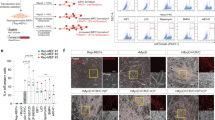Abstract
MyoD of the myogenic regulatory factors (MRFs) family regulates the skeletal muscle differentiation program. In this study, stably transfected NIH3T3-derived cell lines were established, in which exogenous MyoD was expressed at high levels. Transcriptional activation of endogenous muscle regulatory gene and induction towards the skeletal muscle lineages were observed with phase-contrast microscopy when continuously cultured in vitro. Moreover, to determine their ability of myogenic formation in vivo, the transfected cells were implanted in nude mice subcutaneously for up to 10 weeks. The morphological characterization of inductive cells was observed using transmission electron microscope and histological staining. Myogenesis of fibroblasts incubated in the medium was activated by overexpression of MyoD, and the cells were accumulated and fused into multinucleated myotubes. Correlatively, RT-PCR and immunohistochemistry confirmed the increased expression of characteristic downstream molecule myogenin and mysion heavy chains during myogenic differentiation. Ecoptic myogenesis was found and remained stable phenotype when the transfected cells were seeded in vivo. Our results suggest that MyoD can be considered to be a determining factor of myogenic lineages, and it may play an important role in the cell therapy and cell-mediated gene therapy of the skeletal muscle.




Similar content being viewed by others
Reference
Anderson JE (2006) The satellite cell as a companion in skeletal muscle plasticity: currency, conveyance, clue, connector and colander. J Exp Biol 209:2276–2292
Negroni E, Butler-Browne GS, Mouly V (2006) Myogenic stem cells: regeneration and cell therapy in human skeletal muscle. Pathol Biol 54:100–108
Lin Y, Liu L, Li Z, Qiao J, Wu L, Tang W, Zheng X, Chen X, Yan Z, Tian W (2006) Pluripotency potential of human adipose-derived stem cells marked with exogenous green fluorescent protein. Mol Cell Biochem 291:1–10
Nie X, Tian W, Zhang Y, Chen X, Dong R, Jiang M, Chen F, Jin Y (2006) Induction of transforming growth factor-beta 1 on dentine pulp cells in different culture patterns. Cell Biol Int 30:295–300
Weintraub H, Davis R, Tapscott SJ, Thayer M, Krause M, Benezra R, Blackwell TK, Turner D, Rupp R, Hollenberg S, Zhuang Y, Lassar A (1991) The MyoD gene family: nodal point during specification of the muscle cell lineage. Science 251:761–766
Ludolph DC, Konieczny SF (1995) Transcription factor families: muscling in on the myogenic program. FASEB J 9:1595–1604
Li L, Olson EN (1992) Regulation of muscle cell growth and differentiation by the MyoD family of the helix-loop-helix proteins. Advan Cancer Res 58:95–119
Lu BD, Allen DL, Leinwand LA, Lyons GE (1999) Spatial and temporal changes in myosin heavy chain gene expression in skeletal muscle development. Dev Biol 216:312–326
Zhou Z, Bornemann A (2001) MRF4 protein expression in regenerating rat muscle. J Muscle Res Cell Motil 22:311–316
Cooper RN, Tajbakhsh S, Mouly V, Cossu G, Buckingham M, Butler-Browne GS (1999) In vivo satellite cell activation via Myf5 and MyoD in regenerating mouse skeletal muscle. J Cell Sci 112:2895–2901
Russo S, Tomatis D, Collo G, Tarone G, Tato F (1998) Myogenic conversion of NIH3T3 cells by exogenous MyoD family members: dissociation of terminal differentiation from myotube formation. J Cell Sci 111:691–700
Young HE, Rogers JJ, Adkison LR, Lucas PA, Black AC (1998) Muscle morphogenetic protein induces myogenic gene expression in Swiss-3T3 cells. Wound Repair Regen 6:543–554
Weintraub H, (1993) The MyoD family and myogenesis: redundancy, networks, and thresholds. Cell 75:1241–1244
Zhang Y, Tan X, Zhang PJ, Xu Y (2006) Characterization of muscle-regulatory gene, MyoD, from flounder (Paralichthys olivaceus) and analysis of its expression patterns during embryogenesis. Mar Biotechnol 8:139–148
Beylkin DH, Allen DL, Leinwand LA (2006) MyoD, Myf5, and the calcineurin pathway activate the developmental myosin heavy chain genes. Dev Biol 294:541–553
Kami K, Senba E (2005) Galectin-1 is a novel factor that regulates myotube growth in regenerating skeletal muscles. Curr Drug Targets 6:395–405
Joulia D, Bernardi H, Garandel V, Rabenoelina F, Vernus B, Cabello G (2003) Mechanisms involved in the inhibition of myoblast proliferation and differentiation by myostatin. Exp Cell Res 286:263–275
Amthor H, Christ B, Patel K (1999) A molecular mechanism enabling continuous embryonic muscle growth––a balance between proliferation and differentiation. Development 126:1041–1053
Parker MH, Perry RL, Fauteux MC, Berkes CA, Rudnicki MA (2006) MyoD synergizes with the E-protein HEB beta to induce myogenic differentiation. Mol Cell Biol. 26:5771–5783
Bach AD, Beier JP, Stern-Staeter J, Horch RE (2004) Skeletal muscle tissue engineering. J Cell Mol Med 8:413–422
Rando TA, Pavlath GK, Blau HM (1995) The fate of myoblasts following transplantation into mature muscle. Exp Cell Res 220:383–389
Lin Y, Chen X, Yan Z, Liu L, Tang W, Zheng X, Li Z, Qiao J, Li S, Tian W (2006) Multilineage differentiation of adipose-derived stromal cells from GFP transgenic mice. Mol Cell Biochem 285:69–78
Abe T, Takano K, Suzuki A, Shimada Y, Inagaki M, Sato N, Obinata T, Endo T (2004) Myocyte differentiation generates nuclear invaginations traversed by myofibrils associating with sarcomeric protein mRNAs. J Cell Sci 117:6523–6534
Acknowledgment
This work was supported by grants from the Nature Science Foundation of Shaanxi province, China (Project No. 2005k06-G6).
Author information
Authors and Affiliations
Corresponding author
Rights and permissions
About this article
Cite this article
Qin, Rf., Mao, Tq., Gu, Xm. et al. Regulation of skeletal muscle differentiation in fibroblasts by exogenous MyoD gene in vitro and in vivo. Mol Cell Biochem 302, 233–239 (2007). https://doi.org/10.1007/s11010-007-9446-1
Received:
Accepted:
Published:
Issue Date:
DOI: https://doi.org/10.1007/s11010-007-9446-1




